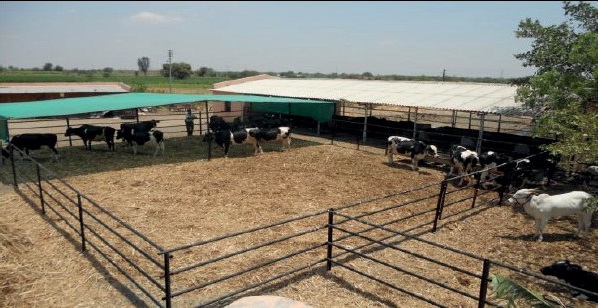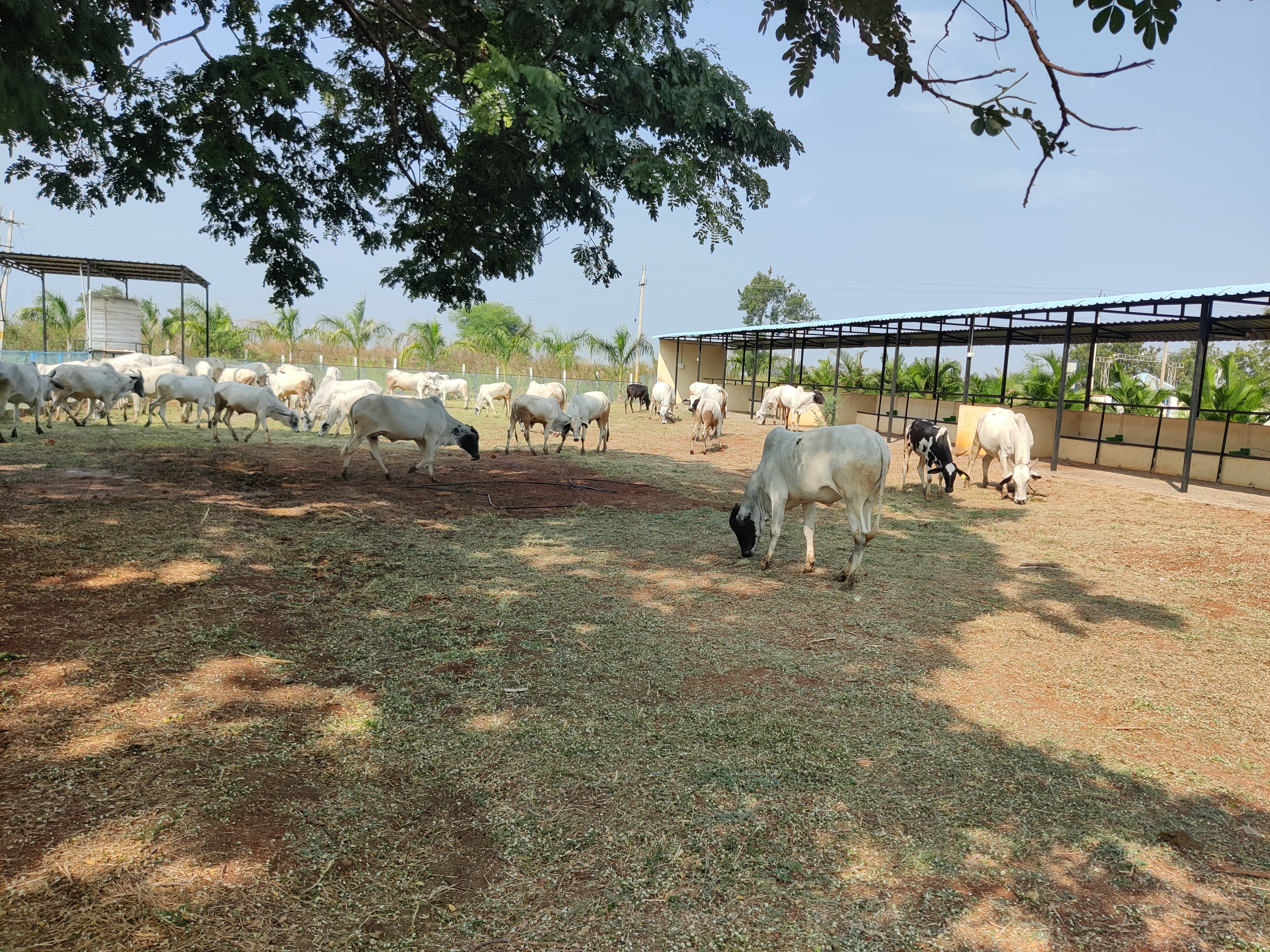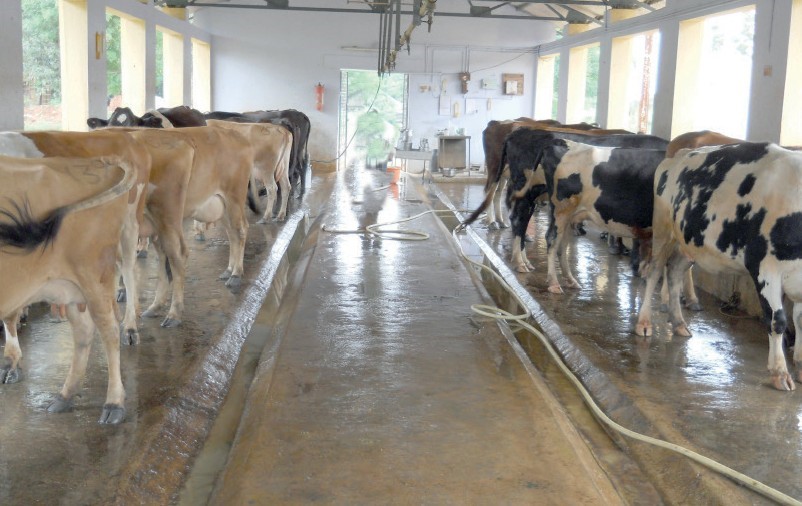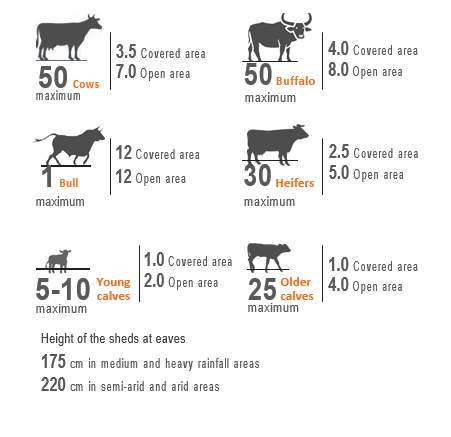Rearing Systems
Extensive system:
Also known as the grazing system, animals are reared on external grazing alone,
in which 90% of dry matter fed to them comes from rangelands, pastures, annual forages and purchased
feed and less than 10% of the total value of production comes from non-livestock farming activities.
Semi-intensive system:
In this system which is most prevalent in India, animals are housed in
covered enclosures. They are taken out to graze during the day and provided feed and fodder when they
return. Quite often, the system is similar to mixed farming system.
Intensive system:
This highly evolved system involves rearing in closed enclosures, where average
stocking rates are greater than 10 livestock units per hectare. Common in developed countries like the
USA and UK, it is also found in the states of Punjab, Haryana, Western Uttar Pradesh in India.
Housing Management
- Among good farming practices, attention to the housing of dairy cattle is important.
- This is essential to ensure safe and quality milk from healthy animals kept under acceptable conditions, buffering the animals from adverse weather conditions.
- Care should be taken to provide comfortable spacing, hygiene, durable housing, and arrangements for hygienic milking.
Types of Housing
- Dairy cattle may be housed under a wide variety of conditions, ranging from close confinement to little restrictions except at milking time.
- Two types of dairy barns are in general use: the loose housing barn in combination with some type of milking barn or parlor and the conventional dairy shed.
Loose Housing
- It is a system of housing in which animals are kept loose in an open paddock throughout the day and night except at the time of milking and during treatment.
- It involves low cost of construction with scope for expansion, facilitates detection of animals in heat, and animals get optimum exercise.
- In this system, shelter is provided along one side of open paddock under which animals can retire when it is very hot or cold or during rains.
- Common feed manger and water tank is provided and concentrates are fed at the milking time which is done in a separate milking barn or parlour in which cows are secured at milking time and are milked.
- The open paddock is enclosed by means of half walls or plain wire fences of convenient height.

Advantages
- Cost of construction is cheaper.
- Future expansion is possible.
- The animals will move freely so that it will get sufficient exercise.
- The animal can be kept clean.
- Common feeding and watering arrangement is possible.
- Clean milk production is possible because the animals are milked in a separate milking barn.
- Oestrus detection is easy.
- At least 10-15 percent more stock than standard can be accommodated for shorter period.

Disadvantages
- It is not suitable for temperate Himalayan region and heavy rainfall areas.
- It requires more floor space.
- There is competition for feed.
- Attention of individual animal is not possible.
- A separate milking barn is needed for milking of animals.
Conventional Shed
- Animals in this system are confined together on a platform and secured at the neck by stanchions or neck chains.
- They are fed as well as milked in the barn, which has a fully covered roof, windows and ventilators.
- The construction of the shed depends on the class of livestock it is meant for and to what use it is to be put. You could have a cow house, calving box, bull shed, isolation box, etc.
- Conventional sheds are costly and therefore, becoming less popular.
- The sheds can be either of a single row when animals are fewer or in two rows if more animals are being reared.
- In double row housing, the arrangement should be such that the cows either face out (tail to tail system) or face in (head to head system).
- The breadth of the shed should not exceed 10 metres and the distance between animals should be 1.0 to 1.2 metres, with each animal having an individual space of 1.5 to 2.0 metres.
- The central height of the shed must be 3.5 to 4.0 metres, sloping at the edges. Good ventilation and flooring are essential.
- The animals are fed as wells as milked in the same barn.
- These barns are completely covered with roofs and the sidewalls are closed with windows or ventilator located at suitable places to get more ventilation and lighting.
- It is applicable for temperate and heavy rainfall region.
- The same type of housing can be utilized for tropical region with slight modification.
Advantages
- The animals and men caring for animals are less exposed to harsh environment.
- The animals can be kept clean.
- Diseases are better controlled.
- Individual care can be given.
- Separate milking barn is not required.
Disadvantages
- Cost of construction is more.
- Future expansion is difficult.
- Not suitable for hot and humid climatic conditions.
Single Row System:
In single row system, 12-16 numbers of animals can be kept.
Double row system:
- If it is greater than 16, then double row system is preferable.
- In double row system up to 50 animals can be maintained in a single shed.
- The distance between two sheds should be greater than 30 feet or it should be twice the height of the
building.
1. Tail to tail system
- Cleaning and milking of animals easy.
- Supervision of milking also easy.
- Less chance for transmission of diseases from animal to animal.
- Animals can get more fresh air from outside.
- This system is more labour friendly system.

2. Head to Head System
- Getting animals into the shed is easy.
- Feeding of animals is also easy.
- Disinfection of the gutter will be more due to the direct fall of sunrays over the gutter.
- Animals are better exhibited to visitors.
Disadvantages
- Milking supervision is difficult.
- Possibilities of transmission of disease are more.
Floor space requirements:
| Type of animal |
Floor space requirement (m2) |
Maximum no of animals / pen |
Height of the shed ( cm) |
| Covered area |
Open area |
| Bulls |
12.0 |
24.0 |
1 |
175 cm. in medium and heavy rain fall and
220 cm. in dry areas.
|
| Cows |
3.5 |
7.0 |
50 |
| Buffaloes |
4.0 |
8.0 |
50 |
| Down – calves |
12.0 |
12.0 |
1 |
| Young – calves |
1.0 |
2.0 |
30 |
| Old – calves |
2.0 |
4.0 |
30 |
Feeding and watering space requirements:
| Type of animal |
Space per animal (cm) |
Total manger length in
a pen for 100 animals(cm)
|
Total water tank length in
a pen for 100 animals (cm)
|
| Adult cattle & buffaloes |
60-75 |
6000-7500 |
600-750 |
| Calves |
40-45 |
4000-5000 |
400-500 |
Floor space (sq. m) for various categories of dairy animals (BIS standards)

Other Sheds in Dairy Farm
Milking Barn / Milk Parlour
- This is a barn where milch animals are milked and is fully covered.
- It should be located at the centre of the farm with all other farm buildings arranged around it.
- There shall be an individual standing in the milking barns and the number of standings required should be 25%
of total number of milch animals in the herd.
- The milking operation should be carried out in batches.
Down calver shed/ calving pen
- Pregnant animals are transferred to a calving pen 2 to 3 weeks before the expected date of calving.
- Calving pen of 3m x 4m (12 m2) is essential to keep the animals in advanced stage of pregnancy.
- It should be located nearer to the farmer’s quarters for better supervision.
- The number of calving pens required is 10% of the number of total breed able female stock in the farm.
Calf pen
- This is meant for housing young calves separately.
- It can be located either at the end or on the side of the milking barn
- This facilitates taking calves to their dams quickly.
- If there are large numbers of calves, the separate unit of calf shed should be arranged and located nearer to
the milking barn.
Young stock/ Heifer shed
- It is meant for housing young heifers separately.
- Older heifers calves from about six months of age to breeding age are to be housed separately from the
suckling calves.
- When a large number of young stocks are there, they should be divided into different age groups and each group
housed separately to facilitate scientific feeding.
Dry animal shed
- In large farms, milch and dry cows are housed separately.
- The floor in the covered area should preferably be made of cement concrete.
- Under Indian conditions, in smaller farms, milch and dry animals can be housed together.
- Normally, one third of the animals in a farm will be in dry or in dry cum pregnant stage.
Bull shed
- It is meant for housing bulls separately in a farm.
- It should be constructed towards one end of the farm.
- There shall be one shed for each bull.
- The number of bulls required being one for every 50 breed able females on the farm, if natural breeding is
practiced.
- When artificial insemination service facilities are available, no necessary to keep the bulls on the farm.
- The bull shed shall have covered 3x4 meter dimensions, leading into a paddock of 120 square meters.
- The bull sheds shall be located in such a way that the bulls are able to see the cows and hear their sounds.
Isolation shed
- It is the separation of sick animals from apparently healthy animals to avoid transmission of diseases to
healthy stock.
- It should be located at the corner of the shed so that these sheds are inaccessible to other animals
Quarantine shed
- It should be located at the entrance of the farm.
- The newly purchased animals entering into the farm should be kept in quarantine shed for a minimum period of
30 to 40 days to watch out for any disease occurrence.





